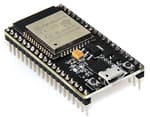The Esp32 microcontroller has been steadily popularity as both an alternative to other well-known microcontrollers, such as Arduino, and as a solid option in its own right. It’s tiny and budget-friendly, has Wi-Fi and dual-mode Bluetooth capabilities, touch and temperature sensors, and has a lot of tools for firmware creation, such as the ESPHome environment and MicroPython. It also gets high marks for being energy-efficient, especially compared to the Esp8266.
One great type of project you can do with the Esp32 are internet of things (IoT) projects, which allow the Esp32 to interact with other devices and the cloud to exchange and analyze data. IoT systems are carried out via items like sensors and software and can include devices that don’t necessarily normally connect to the internet like a computer does.
All in all, the Esp32 lends itself nicely to many IoT projects, and we’ve rounded up some of the coolest, most useful, and most intriguing ones out there. When making our selection, we’ve taken into account replicability, ease of understanding the steps, and additional support such as YouTube videos. We also tried to accommodate a range of Esp32 users, from beginners to those with more experience. Last but not least, whenever possible, we tried to specify the Esp32 model used for the particular project. Let’s get started!
Voice-Controlled WLED
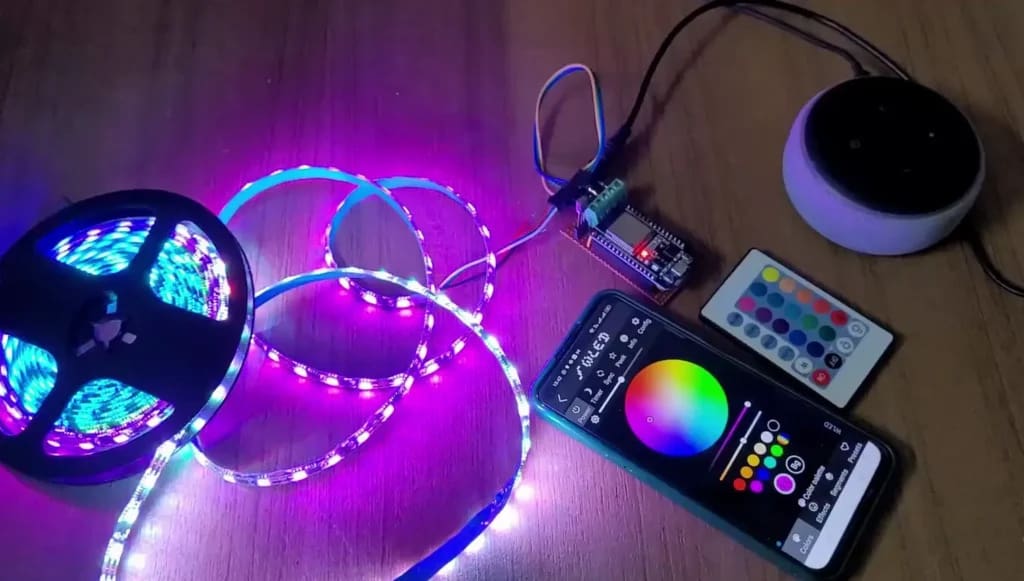
In this beginner-friendly, low budget, and interesting project, you’ll set up your Amazon Echo Dot with the Esp32 to use voice controls and a remote control to operate an LED strip. Note that to use the Alexa function, the Amazon Echo Dot is a necessary component, and if you use a 5-V LED, you won’t need a voltage regulator (as opposed to using 12-V LEDs).
You’ll need to download two apps, the WLED and the Amazon Alexa one. The creator includes a helpful tutorial video that shows how to set up the free WLED app that you’ll need, as well as how to connect it with the Amazon Alexa app. Once you configure everything, via the magic of IoT and the Esp32, you’ll be able to tell Alexa to turn the lights on or off! And depending on the LEDs you’ve got and how much you want to try, you can also set up different modes or effects – not to worry, this is also included in the tutorial.
- Designer: Subhajit
- Difficulty: Beginner
- Core components: Esp32 DevKIT V1, RGB LED strip, Amazon Echo Dot, IR receiver, voltage regulator, pushbutton
- Where to find it: IoT Circuit Hub
Bluetooth iBeacon
Put together this cool Bluetooth iBeacon project, where your Esp32 microcontroller will act as a server and your phone will be the client. The Bluetooth iBeacon allows certain devices, such as smartphones, to carry out tasks when in proximity to the iBeacon.
This is potentially a good choice for shop owners or those trying to establish better marketing techniques, as the iBeacon can enable mobile payments and carry out some mobile marketing tasks.
You’ll be using the nRF Connect app for Android to make it possible. Additionally, it’s a pretty low-budget. While you’ll benefit from some experience, there’s a great explanation on the different lines of code and what you’ll be doing with them, so it’s a nice option for those dipping their feet into the waters of further Esp32 IoT projects.
- Designer: Abhimanyu Pandit
- Difficulty: Advanced beginner
- Core components: Esp32, USB cable
- Where to find it: Circuit Digest
Speaker System
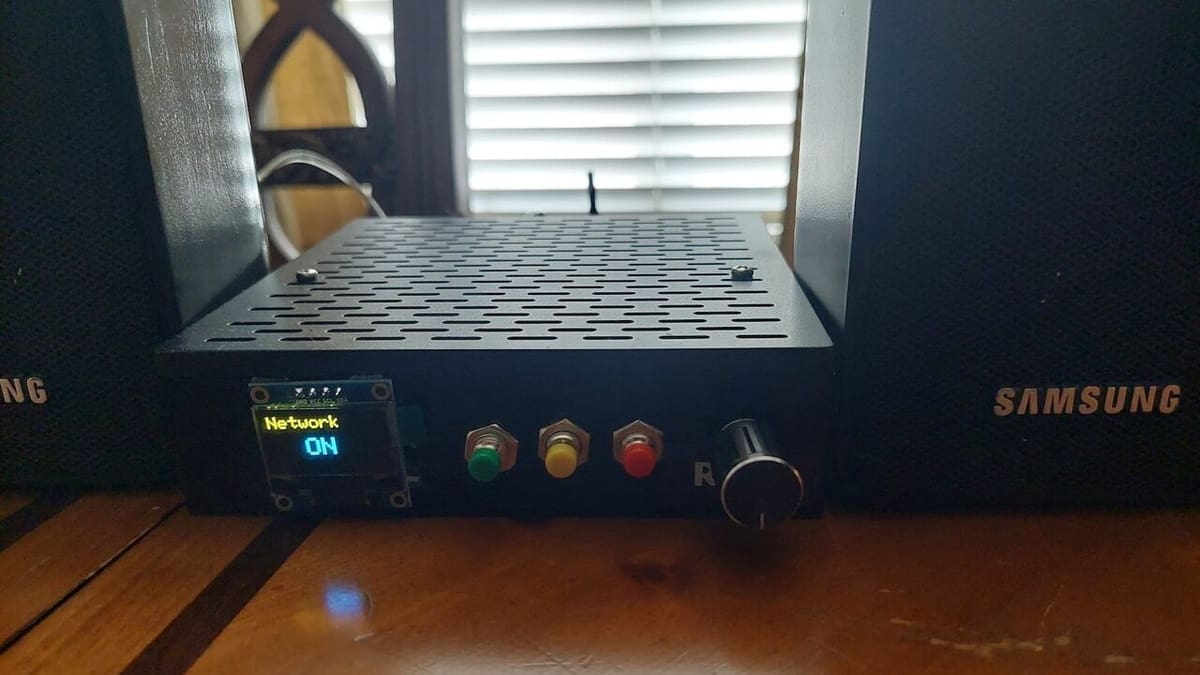
This innovative project allows you to transform your speaker system with the help of the Esp32 to not only play music remotely, but also send announcements that let you know when things like the washing machine have finished or if someone is ringing the doorbell. It’s hooked into the Home Assistant network, which allows it all to be synced together.
One key element to this project is the Arylic Amp; this is the main controller board that takes the Esp32’s, rotary knob’s, and buttons’ commands and carries them out.
The project is laid out clearly with a helpful YouTube video and is appropriate for Esp32 users of all levels of experience. Just keep in mind that it does require a significant number of components.
- Designer: Ryne Gonzales
- Difficulty: Advanced beginner
- Core components: Esp-32 Mini, speakers, Arylic Amp, DC power supply, RGB LED, push buttons, rotary encoder module, JST connector kit, LED display, resistors
- Where to find it: Hackster
Smart Electricity Energy Meter
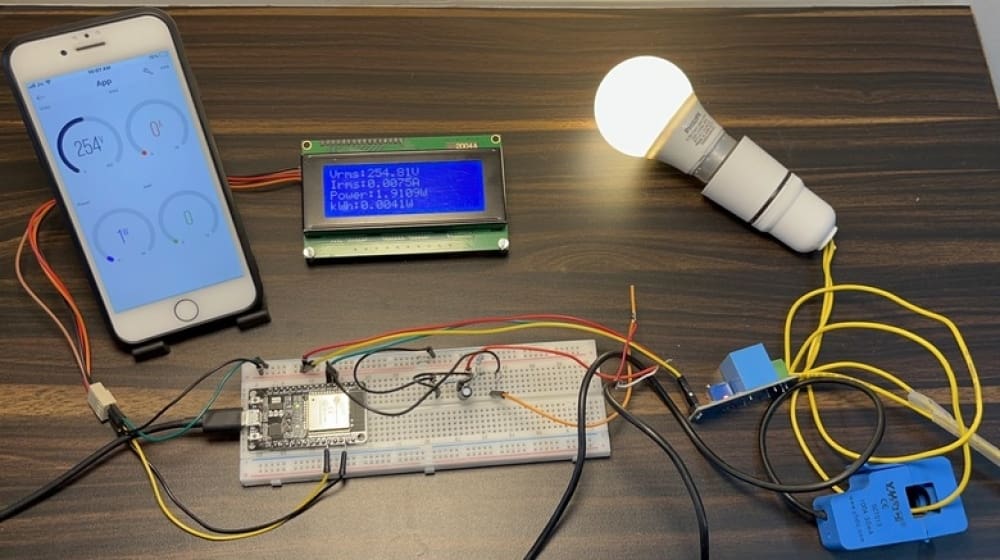
Keeping track of your electricity usage pays off in many ways: It’s environmentally friendly to use less electricity, and you’ll save money on your electric bills. To accomplish this, this Esp32 IoT project is here to help you out.
In order to reduce reliance on manual meter readings, this Esp32 project, in conjunction with the Blynk app, allows you to remotely monitor energy consumption in your household via current and voltage sensors.
The sensors measure voltage and energy consumption and send the readings to the Blynk app. A particularly great thing about using the Esp32 for this project is that if there’s a power outage, the meter data stays stored in the EEPROM of the Esp32, so the data doesn’t get lost.
- Designer: How2Electronics
- Difficulty: Advanced beginner
- Core components: Esp32, AC voltage sensor module, current sensor, LCD
- Where to find it: How2Electronics
Advanced Weather Station

Need to keep track of weather easily at your fingertips? This project has you covered. You’ll work with your Esp32, an integrated environmental sensor, and live weather data via Open Weather Map API. These items will put together a weather station that will keep track of critical weather elements like humidity and temperature with a high level of accuracy. The finished station will give you permanent access to a weather reading in your web browser that features all of the measurements taken.
Overall, not many components are needed for the project, making it a relatively budget-friendly endeavor. While the project is labeled “advanced,” it refers more to the weather station itself. The project is appropriate for users with some experience with Esp32.
- Designer: IoT Design Pro
- Difficulty: Intermediate
- Core components: Esp32, BME280 module, 18650 battery, TP4056 charging module
- Where to find it: IoT Design Pro
Drinking Water Quality Monitoring
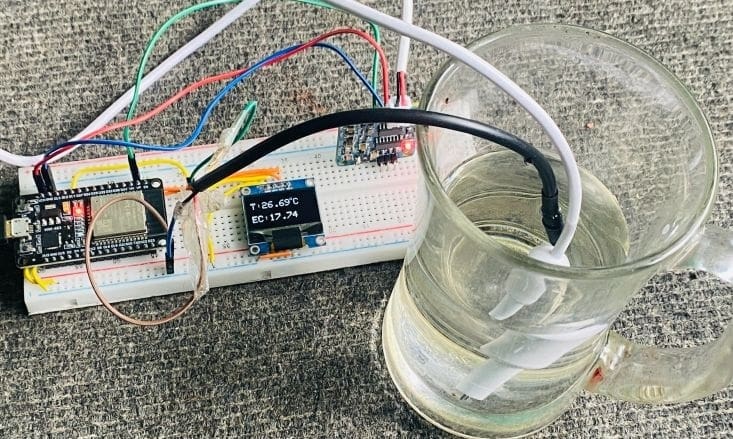
For those uncertain about the quality of their tap water, it’s a high priority to get the assurance that it’s of good quality and safe to drink.
By creating a water quality monitor with your Esp32, you’ll have active data at your fingertips to let you know the electrical conductivity value (EC value). To measure the EC value, a TDS sensor is interfaced with the Esp32, as well as a temperature sensor, which keeps track of the water’s temperature for optimum flavor and quality.
When you’re testing water (as seen above), the OLED gives you the temperature as well as the EC value of your water. The data can be monitored by accessing a dashboard from the IoT Thingspeak server.
- Designer: How2Electronics
- Difficulty: Intermediate
- Core components: Esp32, analog TDS sensor, temperature sensor, OLED
- Where to find it: How2Electronics
Fan Dimmer
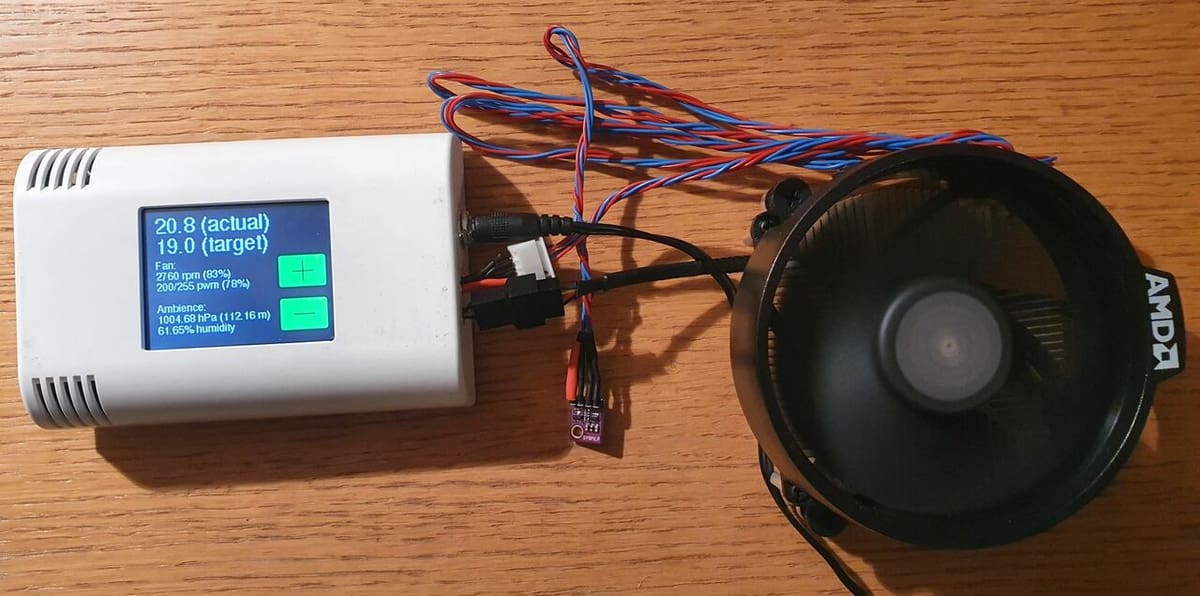
If you live in a place where it gets really hot, this could be an ideal project: An IoT fan dimmer that can be set to a temperature-based mode, allowing the speed to increase automatically as the room temperature gets higher. The project also includes a variety of optional features that you can go for, such as MQTT support and different resolutions of TFT displays, among others. Additionally, you can integrate it to your Home Assistant or openHAB setups.
When it comes to controlling the fan, one of the primary modes is PWM, in which the fan speed is directly set with a pulse width modulation (PWM) signal together with the Esp32 and a temperature sensor. The other mode is based on temperature control, where you can opt to have the fan start automatically based on the difference between the target and actual temperatures.
Depending on whether you opt for Arduino IDE or PlatformIO, the project’s creator has got some useful tips. If you’d like to have an additional touch display, the creator has set up a helpful separate Wiki.
Smart Dustbin
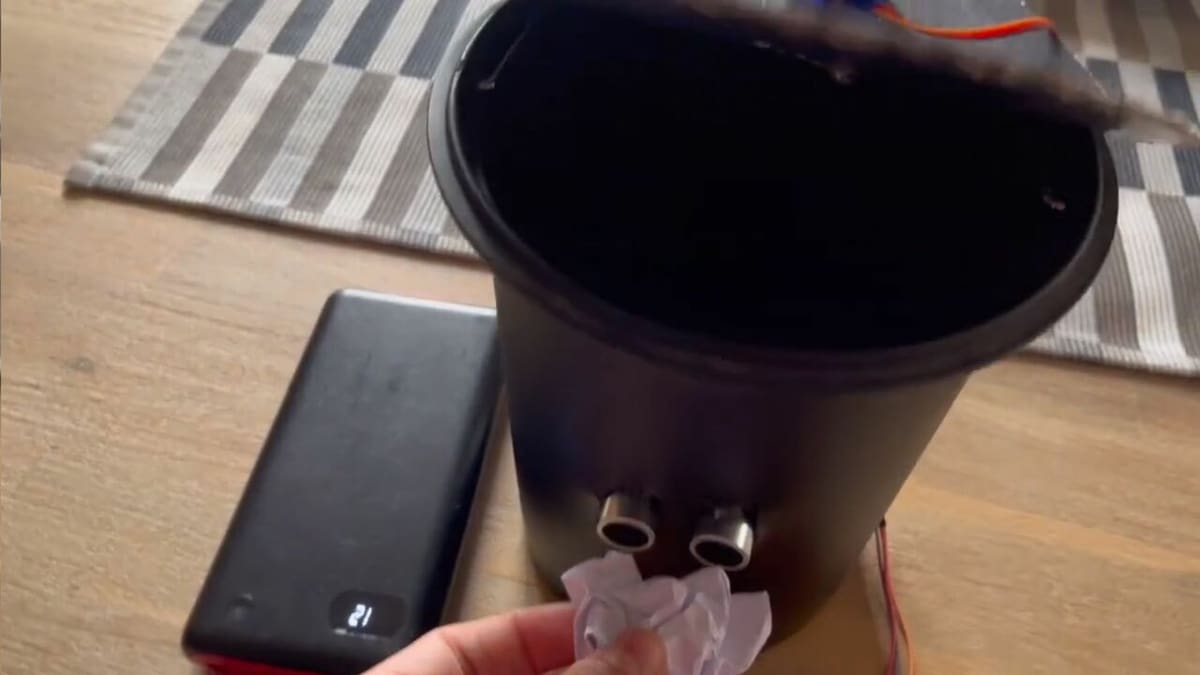
This innovative smart dustbin is able to detect objects in its realm and automatically opens the lid for disposal. It’s all done through the magic of your Esp32 combined with an ultrasonic sensor and RiotOS – no more getting dirty fingers from grabbing the lid of your dustbin!
And while there are smart dustbins aplenty, this one also works with IoT to monitor and analyze the collected data, upping the waste management game.
When the sensor detects an object in its vicinity, your Esp32 microcontroller messages the MQTT broker, which forwards the information to Amazon Web Services AWS IoT. Et voilà! The lid will open for five seconds for you to be able to put the trash into the receptacle. Pretty intelligent!
- Designer: simone pascucci
- Difficulty: Intermediate
- Core components: SparkFun Esp32 Thing, micro servo motor, ultrasonic sensor, dustbin
- Where to find it: Hackster
Smart Gardening & Agriculture
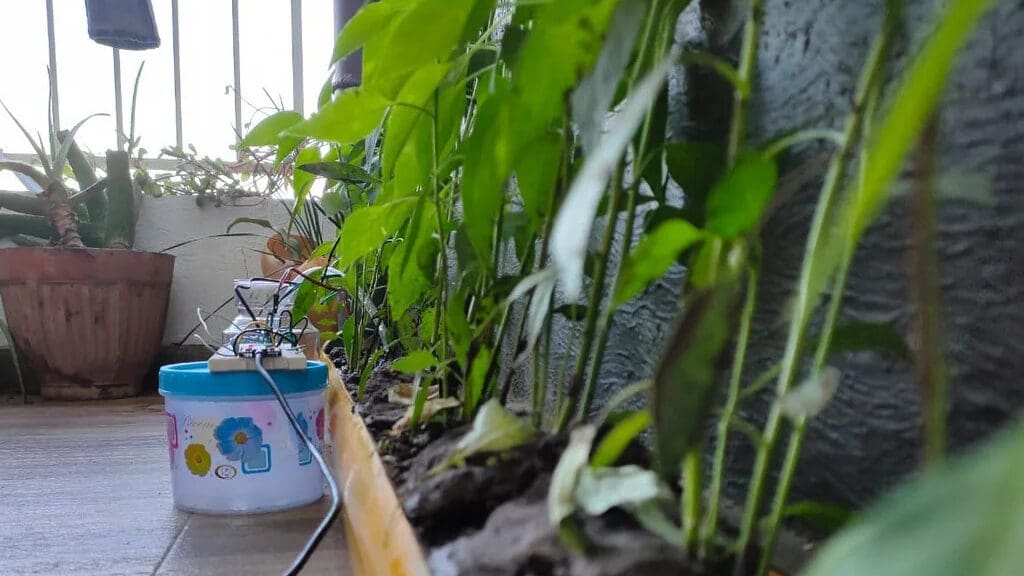
By utilizing temperature and soil moisture sensors, this thoughtful Esp32 IoT project can help you gather data on your plants and garden. The integration of the water pump into the project has you covered, as your plants will receive water when the detected levels of moisture get too low and you remotely turn the motor on.
A light-dependent resistor also keeps track of the sunlight received by plants, so that you can confirm whether they’re at the best possible location or if it’d be better to move them (or to somehow improve their access to light).
In addition to including the code and a useful YouTube tutorial, the project’s creator also included an explanation of what different lines of code are meant to achieve, so you can learn a few more tricks as you’re carrying out this idea.
- Designer: embpic
- Difficulty: Intermediate
- Core components: Esp32, NodeMCU, soil moisture sensor, NTC temperature sensor, LDR sensor, DC water pump
- Where to find it: Instructables, GitHub
Esp32-Cam RC Car Robot Web Server
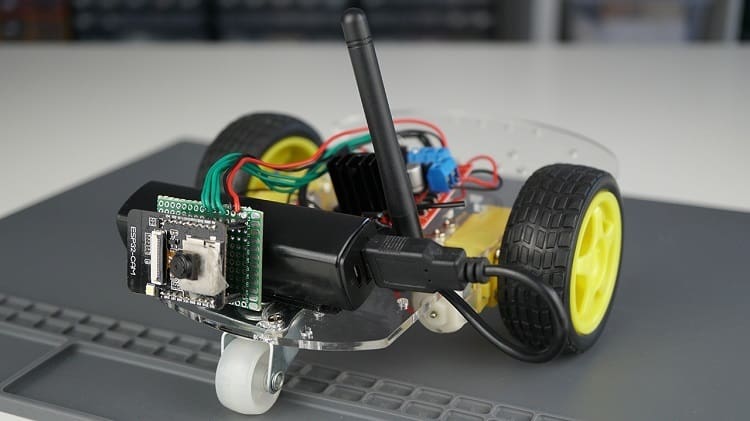
Ever wanted to have a remote-controlled car robot? Here’s your chance to make one of your very own with the Esp32-Cam and a smart robot chassis kit. Once set up, you’ll be able to “tell” your robot with your phone what direction it should travel in. Any Esp32-Cam board should work for this project as long as it has 4 GPIOs, although the project’s creator recommends opting for the version with an external antenna to avoid lagging streams.
You’ll be programming the Esp32-Cam with Arduino IDE, but don’t worry if it’s your first time doing so – the project page includes clear step-by-step instructions that explain different lines of code and the stages of assembly.
Since this project utilizes a camera feature, you get a live stream feed of what your robot is “seeing.” Note that although a smart robot chassis kit is used for the project, any chassis kit works as long as it has two DC motors.
- Designer: Random Nerd Tutorials
- Difficulty: Intermediate
- Core components: Esp32-Cam, smart robot chassis, L298N motor driver, portable charger, optional prototyping circuit board
- Where to find it: Random Nerd Tutorials
License: The text of "The Best Esp32 IoT Projects" by All3DP is licensed under a Creative Commons Attribution 4.0 International License.
CERTAIN CONTENT THAT APPEARS ON THIS SITE COMES FROM AMAZON. THIS CONTENT IS PROVIDED ‘AS IS’ AND IS SUBJECT TO CHANGE OR REMOVAL AT ANY TIME.
